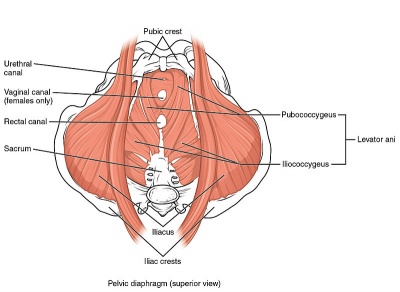Pelvic Girdle Questionnaire (PGQ): Difference between revisions
(replace n+1 occurence of name content) |
Nicole Hills (talk | contribs) mNo edit summary |
||
| Line 4: | Line 4: | ||
'''Top Contributors''' - {{Special:Contributors/{{FULLPAGENAME}}}} | '''Top Contributors''' - {{Special:Contributors/{{FULLPAGENAME}}}} | ||
</div> | </div> | ||
== Objective | == Objective == | ||
[[Image:Pelvic Floor Muscles.jpg|right|400px]] | [[Image:Pelvic Floor Muscles.jpg|right|400px]] | ||
| Line 10: | Line 10: | ||
For people with [[Pregnancy Related Pelvic Pain|Pelvic Girdle Pain]] for use in research and clinical practice. | For people with [[Pregnancy Related Pelvic Pain|Pelvic Girdle Pain]] for use in research and clinical practice. | ||
== Intended Population | == Intended Population == | ||
For people with [[Pregnancy Related Pelvic Pain|Pelvic Girdle Pain]] during pregnancy and postpartum. | For people with [[Pregnancy Related Pelvic Pain|Pelvic Girdle Pain]] during pregnancy and postpartum. | ||
| Line 16: | Line 16: | ||
== Method of Use == | == Method of Use == | ||
Self-report questionnaire of 20 activity items and 5 symptom items on a 4-point response scale. | Self-report questionnaire of 20 activity items and 5 symptom items on a 4-point response scale. | ||
== Evidence == | == Evidence == | ||
The PGQ is the first condition-specific measure developed for people with PGP. The PGQ had acceptably high reliability and validity in people with PGP both during pregnancy and postpartum, it is simple to administer, and it is feasible for use in clinical practice. <ref name="Stuge"/> | The PGQ is the first condition-specific measure developed for people with PGP. The PGQ had acceptably high reliability and validity in people with PGP both during pregnancy and postpartum, it is simple to administer, and it is feasible for use in clinical practice. <ref name="Stuge" /> | ||
=== Reliability === | === Reliability === | ||
| Line 34: | Line 30: | ||
=== Responsiveness === | === Responsiveness === | ||
== Resources == | |||
== | ===== Open Access Article ===== | ||
< | Stuge B, Garratt A, Krogstad Jenssen H, Grotle M. [https://academic.oup.com/ptj/article/91/7/1096/2735055 The pelvic girdle questionnaire: a condition-specific instrument for assessing activity limitations and symptoms in people with pelvic girdle pain]. Physical therapy. 2011 Jul 1;91(7):1096-108.<br> | ||
== References == | == References == | ||
| Line 52: | Line 40: | ||
<references /> | <references /> | ||
[[Category:Womens_Health]] [[Category:Outcome_Measures]] | [[Category:Womens_Health]] | ||
[[Category:Outcome_Measures]] | |||
Revision as of 17:01, 17 August 2018
Original Editor - Your name will be added here if you created the original content for this page.
Top Contributors - Laura Ritchie, Admin, Adam Vallely Farrell, Kim Jackson, Nicole Hills, 127.0.0.1, WikiSysop and Lauren Kwant
Objective[edit | edit source]
For people with Pelvic Girdle Pain for use in research and clinical practice.
Intended Population[edit | edit source]
For people with Pelvic Girdle Pain during pregnancy and postpartum.
Method of Use[edit | edit source]
Self-report questionnaire of 20 activity items and 5 symptom items on a 4-point response scale.
Evidence[edit | edit source]
The PGQ is the first condition-specific measure developed for people with PGP. The PGQ had acceptably high reliability and validity in people with PGP both during pregnancy and postpartum, it is simple to administer, and it is feasible for use in clinical practice. [1]
Reliability[edit | edit source]
Test-retest reliability showed high intraclass correlation coefficient estimates: .93 (95% confidence interval 0.86–0.96) for the PGQ activity subscale and .91 (95% confidence interval 0.84–0.95) for the PGQ symptom subscale. [1]
Validity[edit | edit source]
Responsiveness[edit | edit source]
Resources[edit | edit source]
Open Access Article[edit | edit source]
Stuge B, Garratt A, Krogstad Jenssen H, Grotle M. The pelvic girdle questionnaire: a condition-specific instrument for assessing activity limitations and symptoms in people with pelvic girdle pain. Physical therapy. 2011 Jul 1;91(7):1096-108.
References[edit | edit source]







